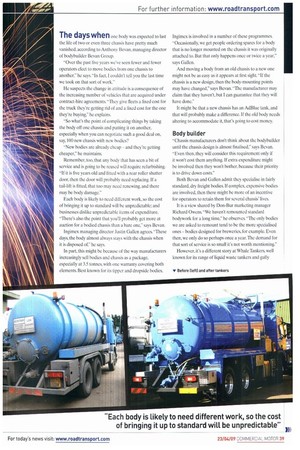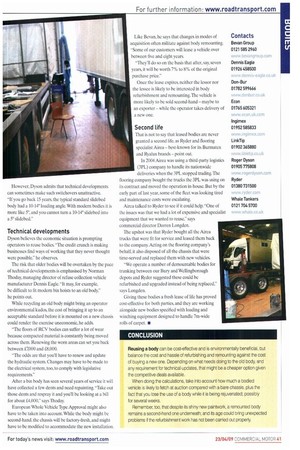The days when one body was expected to last the
Page 39

Page 40

Page 41

If you've noticed an error in this article please click here to report it so we can fix it.
life of two or even three chassis have pretty much vanished, according to Anthony Bevan, managing director of bodybuilder Bevan Group.
"Over the past live years we've seen fewer and fewer operators elect to move bodies from one chassis to another," he says. "In fact, I couldn't tell you the last time we took on that sort of work."
He suspects the change in attitude is a consequence of the increasing number of vehicles that are acquired under contract-hire agreements. "They give fleets a fixed cost for the truck they're getting rid of and a fixed cost for the one they're buying," he explains "So what's the point of complicating things by taking the body off one chassis and putting it on another, especially when you can negotiate such a good deal on, say, 100 new chassis with new bodies?
"New bodies are already cheap and they're getting cheaper," he maintains.
Remember, too, that any body that has seen a bit of service and is going to be reused will require refurbishing. "If it is five years old and fitted with a rear roller shutter door, then the door will probably need replacing. If a tail-lift is fitted, that too may need renewing, and there may be body damage."
Each body is likely to need different work, so the cost of bringing it up to standard will be unpredictable; and businesses dislike unpredictable items of expenditure. "There's also the point that you'll probably get more at auction for a bodied chassis than a bare one," says Bevan.
Ingimex managing director Justin Gallen agrees "These days, the body almost always stays with the chassis when it is disposed of," he says.
In part, this might be because of the way manufacturers increasingly sell bodies and chassis as a package, especially at 3.5 tonnes, with one warranty covering both elements. Best known for its tipper and dropside bodies, id Ingimex is involved in a number of these programmes -Occasionally, we get people ordering spares for a body that is no longer mounted on the chassis it was originally attached to. But that only happens once or twice a year," says Gallen.
And moving a body from an old chassis to a new one might not be as easy as it appears at first sight. "If the chassis is a new design, then the body-mounting points may have changed," says Bevan. 'The manufacturer may claim that they haven't, but I can guarantee that they will have done."
It might be that a new chassis has an AdBlue tank, and that will probably make a difference. If the old body needs altering to accommodate it, that's going to cost money.
Body builder
"Chassis manufacturers don't think about the bodybuilder until the chassis design is almost finalised," says Bevan. "Even then, they will consider this requirement only if it won't cost them anything. If extra expenditure might be involved then they won't bother, because their priority is to drive down costs."
Both Bevan and Gallen admit they specialise in fairly standard, dry freight bodies. If complex, expensive bodies are involved, then there might be more of an incentive for operators to retain them for several chassis' lives.
It is a view shared by Don-Bur marketing manager Richard Owens, "We haven't remounted standard bodywork for a long time," he observes. "The only bodies we are asked to remount tend to be the more specialised ones bodies designed for breweries, for example. Even then, we only do so perhaps once a year. The demand for that sort of service is so small it's not worth mentioning."
However, it's a different story at Whale Tankers, well known for its range of liquid waste tankers and gully emptiers. "We're remounting a lot more bodies at the moment and our workshop is full," reports marketing co-ordinator Tim Pile. "Customers want to make bodies last Service manager Jamie Campbell adds: "The task usually takes about four weeks depending on the complexity of the exercise and how much repair work is required on the tank. It involves performing a tank test to ensure it is still viable and checking all the ancillary equipment."
Increased reliability Says Pile: "Pumps, valves and seals will be replaced as necessary. We change all the looms and pipework to increase reliability and carry out a complete repaint, too," says Campbell.
Additional work might be required if the mounting points on the new chassis are different to those on its predecessor, says Pile.
"You've got more chance of catching Father Christmas than finding two chassis that are the same," agrees Wayne Hodgetts, managing director of LinkTip."The air tanks may he in a different position and the chassis rails may be different, too."
LinkTip's product portfolio includes recycling vehicles and high-lift tippers and it regularly remounts bodies.
At Whale, the tanks are usually about eight or nine years old when they are switched from the old chassis to the new one. "Usually they're reused only once, unless a chassis' life is cut short because it's been written off in an accident," says Campbell.
Some customers are even specifying new bodies with an eye to making future remounts as simple as possible. "A customer recently asked for the eight Kaiser-Whale dirty water recyclers he was ordering to be designed in such a way that it would be easy to move them from an old chassis to a new one," he says. "The tanks were made from stainless steel for longevity."
Andrew Lupton, sales director at gritter and snowplough specialist Econ. says: "Although we don't see it happen as often as we used to, bodies are still refurbished and moved from one chassis to another, usually when they're about seven years old. It typically takes about four weeks and involves stripping the body down, shot-blasting it and then repainting it."
Recovery bodies are also regularly remounted, says recovery equipment manufacturer Roger Dyson, and this was being done long before the credit crunch started to A bite. "One reason why this may happen is that the body may not have been built on a new chassis to begin with," says Dyson. "Consequently, the operator may find that he's fallen foul of the requirements of London's Low Emission Zone (LEZ), "His reaction might be to acquire a compliant chassis and have the body switched over. With a standard slidebed body, the job takes about two weeks, increasing to six to eight weeks if a heavy recovery rig is involved.
"LEZ aside, bodies are usually moved over after they've done between five to seven years on their original chassis," adds Dyson. At that stage, they might have barely started what is likely to be a long life in service.
"We've remounted bodies that are 15 years old," he says. "We've got a 16-year-old body in at the moment that were moving from one chassis to another. It's not a complicated exercise if we had built the equipment originally because we can refer back to the installation drawings. However, a repaint will almost certainly be required and the electrical system may have to be replaced in its entirety." However, Dyson admits that technical developments can sometimes make such switchovers unattractive. "If you go back 15 years, the typical standard slidebed body had a 10-14° loading angle. With modern bodies it is more like 5', and you cannot turn a 10-14" slidebed into a 5° slidebed."
Technical developments
Dyson believes the economic situation is prompting operators to reuse bodies. "The credit crunch is making businesses find ways of working that they never thought were possible," he observes.
The risk that older bodies will be overtaken by the pace of technical developments is emphasised by Norman Thoday, managing director of refuse collection vehicle manufacturer Dennis Eagle. "It may, for example, be difficult to fit modern bin hoists to an old body," he points out.
While recycling an old body might bring an operator environmental kudos, the cost of bringing it up to an acceptable standard before it is mounted on a new chassis could render the exercise uneconomic. he adds.
"The floors of RCV bodies can suffer a lot of wear because compacted material is constantly being moved across them. Renewing the worn areas can set you back between £7,000 and £8,000.
"The odds are that you'll have to renew and update the hydraulic system. Changes may have to be made to the electrical system, too, to comply with legislative requirements."
After a bin body has seen several years of service it will have collected a few dents and need repainting. "Take out those dents and respray it and you'll be looking at a bill for about £4,000," says Thoday.
European Whole Vehicle Type Approval might also have to be taken into account. While the body might be second-hand, the chassis will be factory-fresh, and might have to be modified to accommodate the new installation. Like Bevan, he says that changes in modes of acquisition often militate against body remounting. "Some of our customers will lease a vehicle over between five and eight years.
"They'll do so on the basis that after, say, seven years, it will he worth 7% to 8% of the original purchase price."
Once the lease expires, neither the lessor nor the lessee is likely to be interested in body refurbishment and remounting. The vehicle is more likely to he sold second-hand —maybe to an exporter — while the operator takes delivery of a new one.
Second life
That is not to say that leased bodies arc never granted a second life, as Ryder and flooring specialist Airea — best-known for its Burmatex and Ryalux brands — point out.
In 2004 Airea was using a third-party logistics (3PL) company to handle its nationwide deliveries when the 3PL stopped trading. The flooring company bought the trucks the 3PL was using on its contract and moved the operation in-house. But by the early part of last year, some of the fleet was looking tired and maintenance costs were escalating.
Airea talked to Ryder to see if it could help. "One of the issues was that we had a lot of expensive and specialist equipment that we wanted to reuse,says commercial director Darren Longden.
The upshot was that Ryder bought all the Airea trucks that were fit for service and leased them back to the company. Acting on the flooring company's behalf, it also disposed of all the chassis that were time-served and replaced them with new vehicles.
"We operate a number of demountable bodies for trunking between our Bury and Wellingborough depots and Ryder suggested these could be refurbished and upgraded instead of being replaced," says Longden.
Giving these bodies a fresh lease of life has proved cost-effective for both parties, and they are working alongside new bodies specified with loading and winching equipment designed to handle 7m-wide rolls of carpet. •
















































































































































